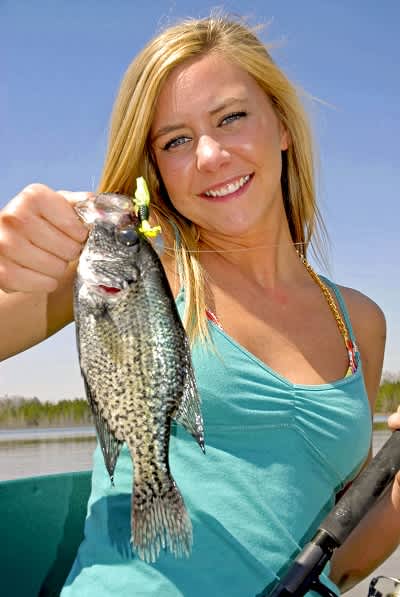Learn about Fishing for Summertime Crappie in New eBook
John E. Phillips 08.07.12

The air temperature was more than 100 degrees, the sun was beating down, and I was praying that my sunscreen would protect my hide, so at the end of the day, my skin wouldn’t look like a burnt piece of bacon. I couldn’t believe we were fishing 50-yards from the bank on the main river channel of the Alabama River in south/central Alabama in the blazing heat of an August day. “As soon as the current starts running from the hydroelectric plant upstream, we’ll start catching crappie,” my fishing buddy, Phillip Criss of McCalla, Ala., said.
The place we were fishing was an old underwater creek channel that fed out into the main river channel. Along the edge and just below the lip of the break, crappie stacked-up there when the current ran through the river. “Those crappie hold in the cool water of that creek channel, and when the current starts to move, the baitfish also will move right on the edge of that creek channel,” Criss explained. “The crappie holding below the baitfish can come-up to the edge of the creek channel, eat the minnows and other baitfish running the lip of the break and then drop-back down into cool water. Cast your minnows up-current. We’ll set our bobbers to hold them about 2-inches above the bottom. When that minnow washes over the lip of the old creek channel, be ready to set the hook.”
From about 10:00 am to 1:30 pm in intense sun and high temperatures, we caught 1- to 1-1/2-pound crappie on almost-every cast. This crappie-fishing trip was the most-unbelievable I’d ever been on, especially in the Dog Days of summer when most people were sitting in their homes on the weekend drinking iced tea and hugging their air conditioners. “Crappie don’t die when the weather gets hot,” Criss told me. “But they do hold in cooler, deeper water. However, when the current starts running through a river or a lake, it’s bringing cool water from the bottom of the lake upstream and causing the baitfish to become extremely active in shallow water. This baitfish movement makes the crappie come-up from their deep-water haunts and attack the baitfish. Can you believe that with an air temperature of 102 degrees, we’re catching crappie in 4 feet of water?” I answered, “No, I don’t believe it, and I’m watching it happen.” Criss went on to explain that he catches crappie all-summer long when the weather’s extremely hot, and the demand for electricity causes power companies to run water-generating plants that create currents in rivers and lakes.
To learn more ways to catch crappie when the weather sizzles, check-out John E. Phillips’ book “Crappie: How to Catch them Spring and Summer” at http://www.amazon.com/Crappie-Catch-Spring-Summer-ebook/dp/B007IV9A14/. Too, you can go to http://www.amazon.com/kindle-ebooks and type-in the name of the book to find it. You also can download a free Kindle app that enables you to read the book on your iPad, computer or SmartPhone.

